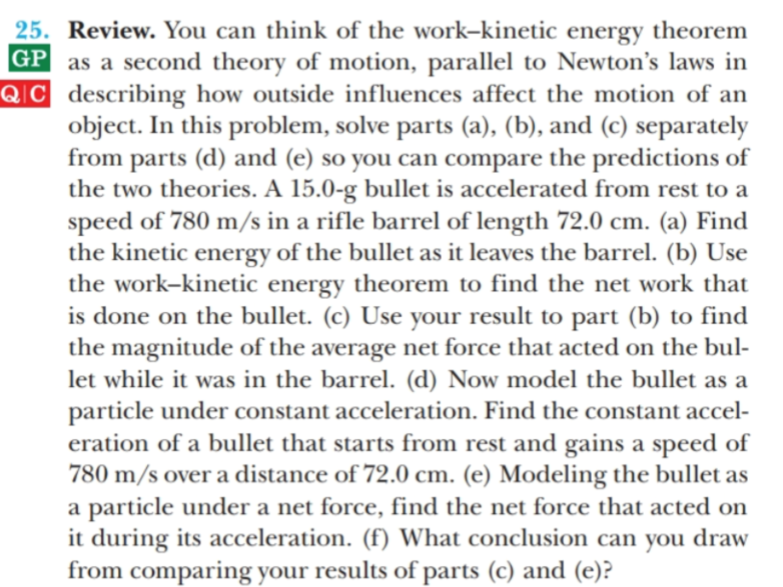25. Review. You can think of the work-kinetic energy theorem GP as a second theory of motion, parallel to Newton's laws in QIC describing how outside influences affect the motion of an object. In this problem, solve parts (a), (b), and (c) separately from parts (d) and (e) so you can compare the predictions of the two theories. A 15.0-g bullet is accelerated from rest to a speed of 780 m/s in a rifle barrel of length 72.0 cm. (a) Find the kinetic energy of the bullet as it leaves the barrel. (b) Use the work-kinetic energy theorem to find the net work that is done on the bullet. (c) Use your result to part (b) to find the magnitude of the average net force that acted on the bul let while it was in the barrel. (d) Now model the bullet as a particle under constant acceleration. Find the constant accel eration of a bullet that starts from rest and gains a speed of 780 m/s over a distance of 72.0 cm. (e) Modeling the bullet as a particle under a net force, find the net force that acted on it during its acceleration. (f) What conclusion can you from comparing your results of parts (c) and (e)? draw
25. Review. You can think of the work-kinetic energy theorem GP as a second theory of motion, parallel to Newton's laws in QIC describing how outside influences affect the motion of an object. In this problem, solve parts (a), (b), and (c) separately from parts (d) and (e) so you can compare the predictions of the two theories. A 15.0-g bullet is accelerated from rest to a speed of 780 m/s in a rifle barrel of length 72.0 cm. (a) Find the kinetic energy of the bullet as it leaves the barrel. (b) Use the work-kinetic energy theorem to find the net work that is done on the bullet. (c) Use your result to part (b) to find the magnitude of the average net force that acted on the bul let while it was in the barrel. (d) Now model the bullet as a particle under constant acceleration. Find the constant accel eration of a bullet that starts from rest and gains a speed of 780 m/s over a distance of 72.0 cm. (e) Modeling the bullet as a particle under a net force, find the net force that acted on it during its acceleration. (f) What conclusion can you from comparing your results of parts (c) and (e)? draw
College Physics
1st Edition
ISBN:9781938168000
Author:Paul Peter Urone, Roger Hinrichs
Publisher:Paul Peter Urone, Roger Hinrichs
Chapter7: Work, Energy, And Energy Resources
Section: Chapter Questions
Problem 61PE: Integrated Concepts A 75.0-kg cross-country skier is climbing a 3.0° slope at a constant speed of...
Related questions
Question

Transcribed Image Text:25. Review. You can think of the work-kinetic energy theorem
GP as a second theory of motion, parallel to Newton's laws in
QIC describing how outside influences affect the motion of an
object. In this problem, solve parts (a), (b), and (c) separately
from parts (d) and (e) so you can compare the predictions of
the two theories. A 15.0-g bullet is accelerated from rest to a
speed of 780 m/s in a rifle barrel of length 72.0 cm. (a) Find
the kinetic energy of the bullet as it leaves the barrel. (b) Use
the work-kinetic energy theorem to find the net work that
is done on the bullet. (c) Use your result to part (b) to find
the magnitude of the average net force that acted on the bul
let while it was in the barrel. (d) Now model the bullet as a
particle under constant acceleration. Find the constant accel
eration of a bullet that starts from rest and gains a speed of
780 m/s over a distance of 72.0 cm. (e) Modeling the bullet as
a particle under a net force, find the net force that acted on
it during its acceleration. (f) What conclusion can you
from comparing your results of parts (c) and (e)?
draw
Expert Solution
This question has been solved!
Explore an expertly crafted, step-by-step solution for a thorough understanding of key concepts.
This is a popular solution!
Trending now
This is a popular solution!
Step by step
Solved in 6 steps with 6 images

Recommended textbooks for you

College Physics
Physics
ISBN:
9781938168000
Author:
Paul Peter Urone, Roger Hinrichs
Publisher:
OpenStax College

University Physics Volume 1
Physics
ISBN:
9781938168277
Author:
William Moebs, Samuel J. Ling, Jeff Sanny
Publisher:
OpenStax - Rice University

College Physics
Physics
ISBN:
9781305952300
Author:
Raymond A. Serway, Chris Vuille
Publisher:
Cengage Learning

College Physics
Physics
ISBN:
9781938168000
Author:
Paul Peter Urone, Roger Hinrichs
Publisher:
OpenStax College

University Physics Volume 1
Physics
ISBN:
9781938168277
Author:
William Moebs, Samuel J. Ling, Jeff Sanny
Publisher:
OpenStax - Rice University

College Physics
Physics
ISBN:
9781305952300
Author:
Raymond A. Serway, Chris Vuille
Publisher:
Cengage Learning

Principles of Physics: A Calculus-Based Text
Physics
ISBN:
9781133104261
Author:
Raymond A. Serway, John W. Jewett
Publisher:
Cengage Learning

Physics for Scientists and Engineers, Technology …
Physics
ISBN:
9781305116399
Author:
Raymond A. Serway, John W. Jewett
Publisher:
Cengage Learning

College Physics
Physics
ISBN:
9781285737027
Author:
Raymond A. Serway, Chris Vuille
Publisher:
Cengage Learning